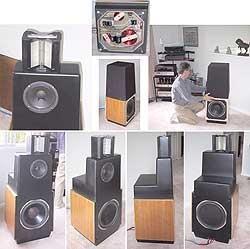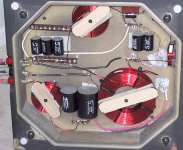The thing about passive crossovers is that you first have to establish the frequency and impedance curves of each driver (trusting published graphs is arguably a wild card), figure out if you need any resistors to match efficiency levels, then calcuculate the reactive components, build it, and then measure with pink noise or sinewaves and an RTA or spectrum analyzer or O-scope to see what each driver is then ACTUALLY doing. I've never had it come out accurate based on theory alone (I've built dozens of speaker systems over the decades). Then fine tune the values, and try both phases for the tweeter to see which has the smoother transition through the crossover frequency, and only then can it be considered well done. It's not even enough to know the driver impedance at the crossover frequency, because the impedance curve is often not at all flat in the adjacent frequencies, and that throws off how the reactive components will operate.
FWIW, the last couple of very successful passive crossovers I've been involved with were designed using LinearX LMS/LEAP software.
Ground-plane semi-anechoic measurements -both gated and not- were taken of the drivers in the actual enclosures and with damping fill levels to be employed. Modeling is great, but I think this is the only way to include the effect of the enclosure on the drivers' real world performance that the networks need to "work with/ around" .
The combination of the FR and impedance measures were then used, along with published rated X-max /power handling, and an intended crossover point to iterate the required values to achieve desired results.
My favorite so far was the parallel LR4 scheme for a big Alpair MTM that had previously been actively bi-amped. A series network was designed for the same system, but -perhaps as it gave much better control over the LF roll-off of the A7.3 - the parallel worked much more to my liking.
No in room measurements were taken after construction - just listening.
Of course, a minidsp / biamped & DDRC system would very likely outperform this, particularly with the Dirac correction, but I've not got to that point yet.
Ground-plane semi-anechoic measurements -both gated and not- were taken of the drivers in the actual enclosures and with damping fill levels to be employed. Modeling is great, but I think this is the only way to include the effect of the enclosure on the drivers' real world performance that the networks need to "work with/ around" .
The combination of the FR and impedance measures were then used, along with published rated X-max /power handling, and an intended crossover point to iterate the required values to achieve desired results.
My favorite so far was the parallel LR4 scheme for a big Alpair MTM that had previously been actively bi-amped. A series network was designed for the same system, but -perhaps as it gave much better control over the LF roll-off of the A7.3 - the parallel worked much more to my liking.
No in room measurements were taken after construction - just listening.
Of course, a minidsp / biamped & DDRC system would very likely outperform this, particularly with the Dirac correction, but I've not got to that point yet.
Last edited:
I would just like to point out that even experienced crossover designers may start thinking about an LR4 arrangement, but abandon it once they get into simulation due to it not being worth the effort. Definitely not something I'd suggest a beginner attempt, but for some reason every couple of months there is one here who does.
Best,
Erik
Best,
Erik
Erik - I've avoided designing my own passive crossovers for lots of reasons, but the designer in this case was certainly experienced enough that the results were demonstrably better to my ears than either of the 2 active bi-amp approaches tried for the same system - the standard cheapie PLLXO and full digital XO courtesy of Onkyo TX NR818.
The same fellow also designed the 3-way for these approx 15yrs ago, and the customer is still pretty happy. ESS Heil AMT1 rebuild, with Eminence 6" midrange - think you can fit that all under newly built stock sized grille cover?
Those original 70s vintage boxes were "not particularly well built" - I'm being polite.

The same fellow also designed the 3-way for these approx 15yrs ago, and the customer is still pretty happy. ESS Heil AMT1 rebuild, with Eminence 6" midrange - think you can fit that all under newly built stock sized grille cover?
Those original 70s vintage boxes were "not particularly well built" - I'm being polite.

Attachments
I want to second what chrisb says above. Published graphs of speaker drivers are usually done with the driver mounted on a large wall facing into an anechoic chamber. While that has value, it's very different than how any driver will be used in the real world (baffle step).
Building a speaker system that is sloppy but OK for most people isn't real hard, but building one that is excellent is MUCH harder. Personally, I'm much happier with 4th order active crossovers (put ahead of the power amps) that include low bass EQ feeding closed box woofers, so the acoustic response is flat and tight down to 30HZ. The amount of time it takes to get a passive crossover properly calibrated can be as much as the time it takes to design and build an active crossover chassis and obtain another poweramp. For several reasons, the latter is pretty likely to sound significantly better.
Building a speaker system that is sloppy but OK for most people isn't real hard, but building one that is excellent is MUCH harder. Personally, I'm much happier with 4th order active crossovers (put ahead of the power amps) that include low bass EQ feeding closed box woofers, so the acoustic response is flat and tight down to 30HZ. The amount of time it takes to get a passive crossover properly calibrated can be as much as the time it takes to design and build an active crossover chassis and obtain another poweramp. For several reasons, the latter is pretty likely to sound significantly better.
Erik - perhaps you're not as consistently concise as you think - I know I certainly have that problem more often than not.
I find that four fingers measure of a nice craft gin can yield the same results - I'm just not sure I want to know what kinda shape my liver is in.
I find that four fingers measure of a nice craft gin can yield the same results - I'm just not sure I want to know what kinda shape my liver is in.
Last edited:
One solution that worked very well for me in many cases:
If you use a 5-8" woofer that has a natural rolloff shortly after the intended X-over frequency, and say a 1" tweeter with low enough Fs (around or below 1kHz), then use an asymmetrical crossover, 2nd order low-pass (or 1st order with Zobel), and a 3rd order high pass, with inverted polarity tweeter. In most cases it sounds, and measures above expectations. Of course you need to "fine tune" the values empirically, but it is easier than it sounds, with white noise, and a few good recordings.
If you use a 5-8" woofer that has a natural rolloff shortly after the intended X-over frequency, and say a 1" tweeter with low enough Fs (around or below 1kHz), then use an asymmetrical crossover, 2nd order low-pass (or 1st order with Zobel), and a 3rd order high pass, with inverted polarity tweeter. In most cases it sounds, and measures above expectations. Of course you need to "fine tune" the values empirically, but it is easier than it sounds, with white noise, and a few good recordings.
- Status
- This old topic is closed. If you want to reopen this topic, contact a moderator using the "Report Post" button.
- Home
- Loudspeakers
- Multi-Way
- Question about wiring of second order crossovers
